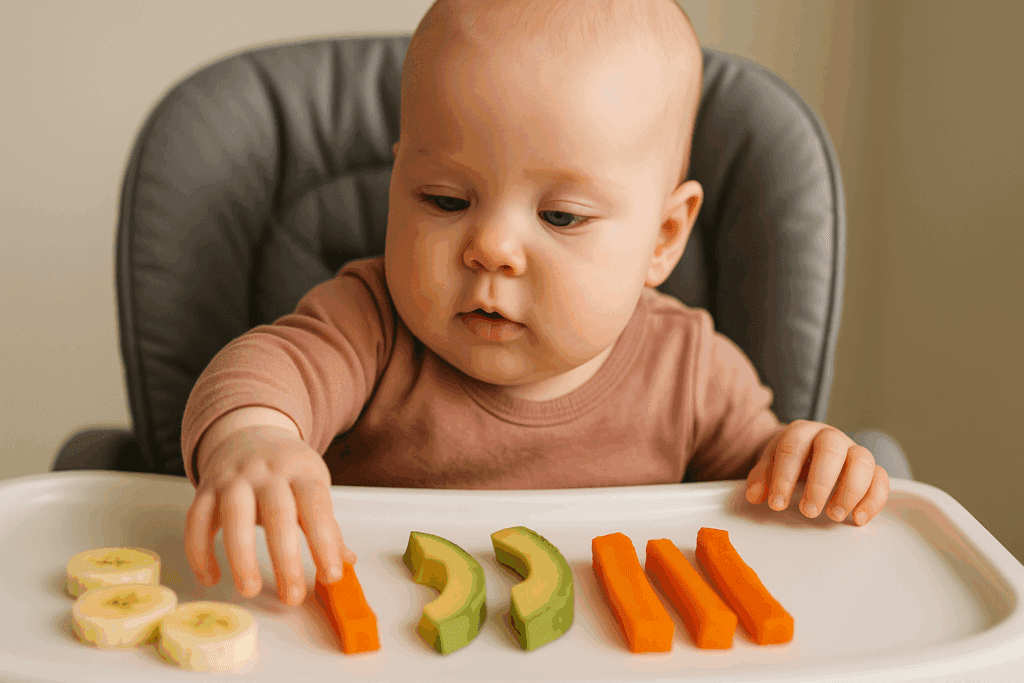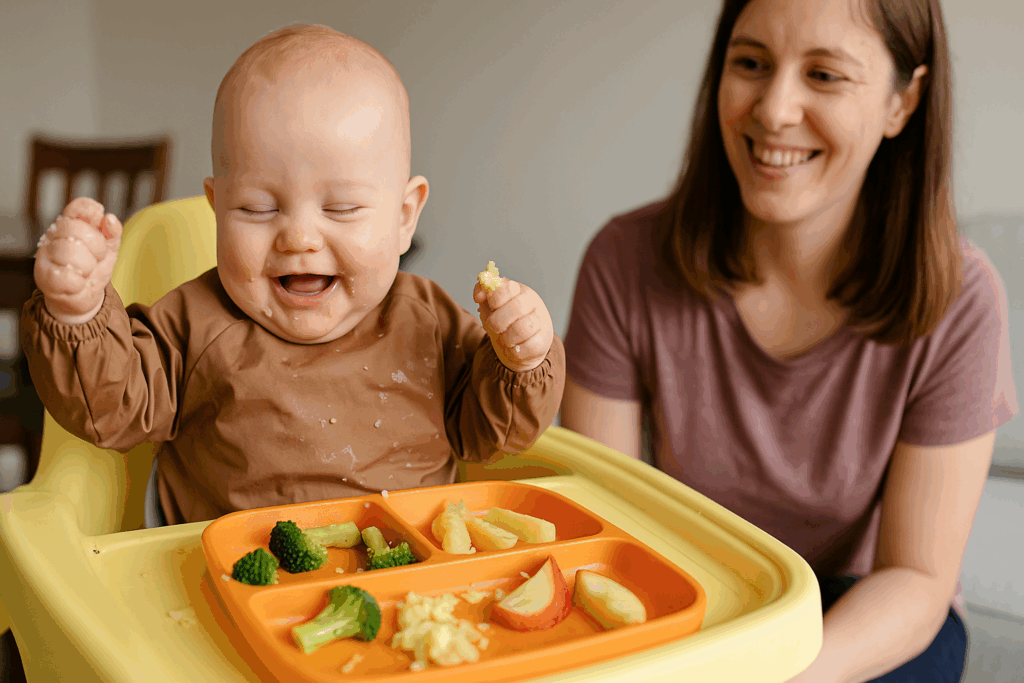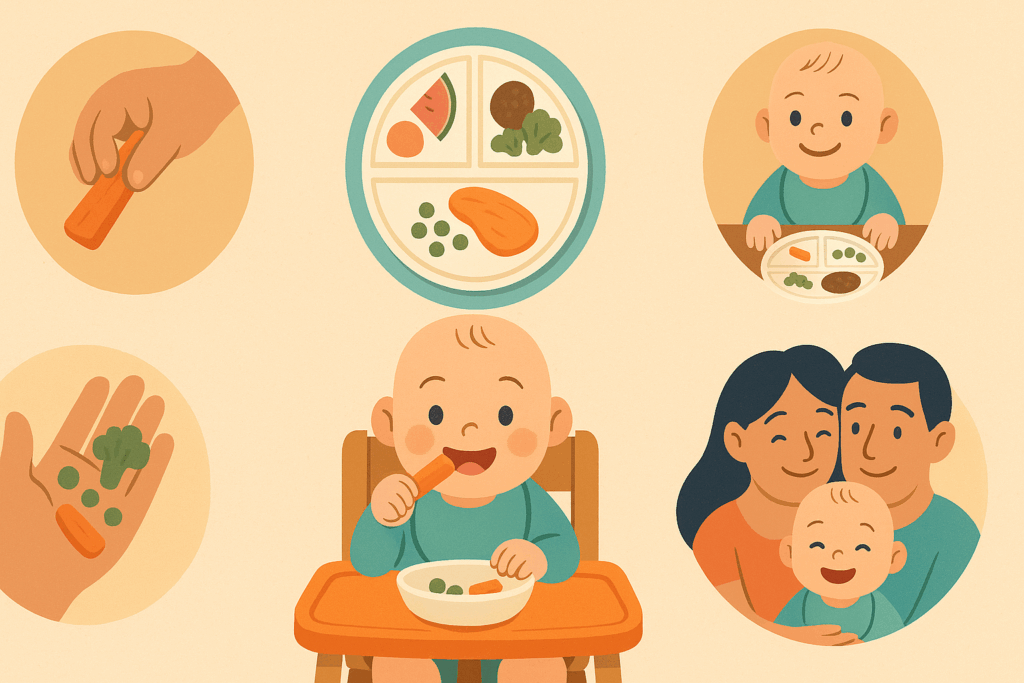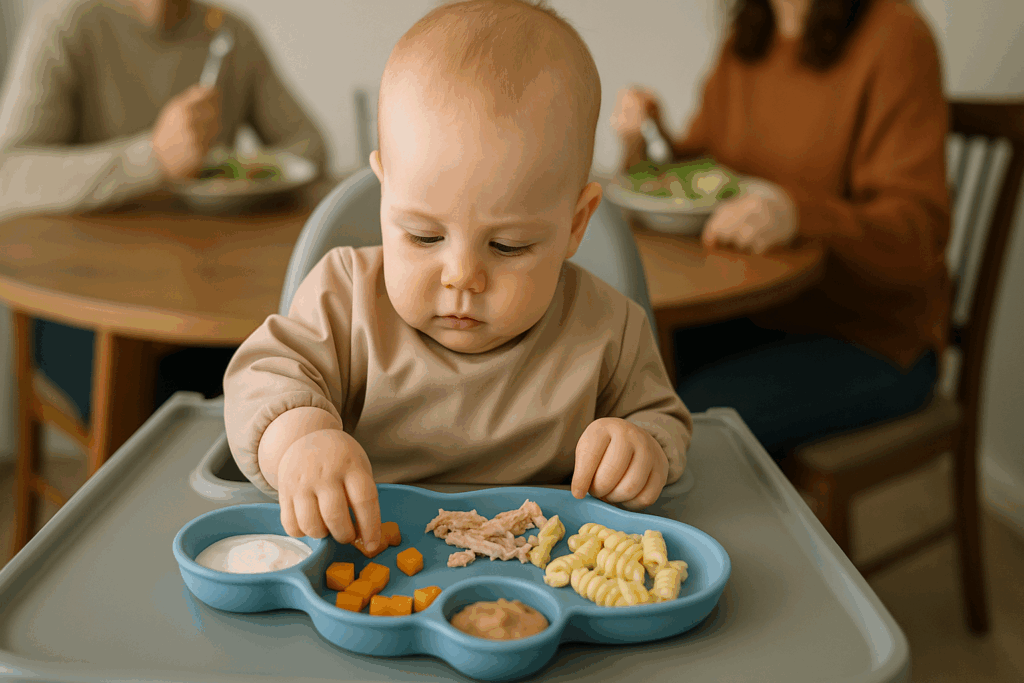In recent years, more parents and caregivers have discovered the growing appeal of baby-led weaning as a practical and developmentally appropriate alternative to traditional spoon-feeding. This method, which empowers infants to self-feed solid foods from the outset, aligns seamlessly with modern understandings of infant nutritional development and autonomy. While some may initially feel apprehensive about introducing whole foods to a six-month-old, countless families find that baby-led weaning (BLW) encourages healthier eating patterns, improves motor skills, and fosters an independent relationship with food. For parents navigating the intricate world of early childhood nutrition, understanding the milestones and benefits of baby led weaning is essential for promoting lasting well-being in their children.
You may also like: The Ultimate Guide to Choosing an Effective Immune Support Supplement for Daily Wellness

What Does Baby Led Weaning Mean? Understanding the Fundamentals
At its core, baby led weaning is a feeding approach that allows babies to explore food in its natural form, bypassing the need for purees or spoon-feeding by adults. Instead of preparing traditional baby food, parents offer age-appropriate solids like steamed vegetables, soft fruits, or mashed legumes that babies can grasp and bring to their mouths themselves. The term “weaning” in this context refers not to the end of breastfeeding or formula, but to the gradual introduction of complementary foods alongside milk feeds. This method is typically introduced around six months of age, a time when most babies are developmentally ready to sit upright, grasp objects, and bring items to their mouth—all critical indicators that they are prepared for solid food.
Understanding what does baby led weaning mean involves more than just offering finger foods; it requires a fundamental shift in the way we perceive infant feeding. Rather than focusing solely on nutrition, BLW emphasizes the development of lifelong eating habits. Infants learn to listen to hunger and fullness cues, explore different textures and flavors, and become active participants in family mealtimes. This sense of agency can significantly impact how children relate to food in later life, reducing the risk of picky eating or food-related anxieties. By introducing a wide variety of healthy foods early, parents also lay the foundation for balanced eating and nutritional resilience.

When Can You Start Baby Led Weaning and How to Know Your Baby Is Ready
Knowing when to start baby led weaning can greatly influence the success of this feeding approach. According to pediatric nutrition guidelines, babies are typically ready to begin BLW around six months of age. However, the exact timing should depend on individual developmental signs rather than a strict age threshold. Some of the clearest indicators that an infant is prepared for baby led weaning include the ability to sit upright unassisted, display of hand-to-mouth coordination, and a keen interest in watching others eat.
Parents often ask, “When can you start BLW safely and effectively?” The answer lies in recognizing the signs of readiness rather than adhering to a calendar date. For instance, if a baby can sit stably in a high chair, grab soft foods, and bring them to their mouth, then BLW may be a suitable next step. Furthermore, if the baby has lost the tongue-thrust reflex, which causes young infants to push foreign objects out of their mouth, this is another positive sign that they are developmentally primed for solids.
It is also important to distinguish between readiness and eagerness. Some babies may show interest in food before six months, such as mimicking chewing motions or reaching for items on a parent’s plate. While these behaviors indicate curiosity, they do not always mean the baby is physiologically ready for solids. Waiting until all readiness cues are present ensures that the infant can safely handle solid textures and reduces the risk of choking.

Baby Led Weaning at 6 Months: Building Confidence in First Foods
Starting baby led weaning at 6 months marks a pivotal transition in an infant’s nutritional journey. At this age, breast milk or formula still provides the bulk of a baby’s nutrients, but complementary feeding becomes essential for introducing iron-rich foods and exposing the child to various tastes and textures. This is where baby led weaning 6 months strategies come into play—they focus on safety, variety, and allowing the baby to explore at their own pace.
For parents unsure of where to begin, soft-cooked vegetables like carrots, sweet potatoes, or broccoli florets make excellent starter options. These items are part of a broader baby led weaning food list that prioritizes safety and nutrition. Foods should be soft enough to squish between fingers, long enough to grasp easily, and free from added salt or sugar. Banana spears, avocado slices, and steamed apple wedges also qualify as some of the best baby led weaning foods for beginners.
Parents introducing BLW at this age may worry about their baby consuming too little, but it is important to remember that the goal of this stage is exploration rather than full meals. Babies learn about food through touch, smell, and taste, and they often spend more time playing with food than eating it. Trusting the process and allowing the baby to control the pace of eating nurtures both confidence and curiosity.
Baby Led Weaning First Foods: A Foundational Step Toward Lifelong Health
Choosing appropriate baby led weaning first foods is a crucial step in shaping a child’s palate and nutritional preferences. These early foods should not only be safe and easy to grasp, but also nutrient-dense and reflective of the family’s typical diet. By integrating the baby into the family meal experience, parents reinforce the social aspect of eating while modeling healthy behaviors.
Popular choices for first foods include avocado slices, soft-boiled egg quarters, roasted sweet potato sticks, and ripe peach wedges. These items provide essential vitamins and minerals while offering diverse textures and flavors. For protein, shredded chicken, flaky fish, or mashed lentils are often included in the BLW food list, as they supply iron, zinc, and healthy fats. Offering such variety early on helps establish a broader acceptance of foods later in childhood.
Parents should avoid highly processed items, hard raw vegetables, and round foods that pose a choking hazard, such as whole grapes or cherry tomatoes unless they are cut appropriately. Moreover, introducing allergens like peanut butter, eggs, or dairy in a controlled and safe manner is encouraged after consulting with a pediatrician. These practices not only support immune development but also normalize allergenic foods as part of the diet.

Benefits of Baby Led Weaning: From Developmental Growth to Nutritional Resilience
The benefits of baby led weaning extend beyond nutrition, offering a holistic approach to child development and well-being. One of the most well-documented benefits of BLW is its positive impact on motor skill development. As babies learn to grasp and self-feed, they improve their hand-eye coordination, dexterity, and oral motor function. These skills translate into smoother transitions to utensil use and more confident eating habits in toddlerhood.
In addition to motor development, baby led weaning encourages better appetite regulation. When babies control what and how much they eat, they develop a stronger awareness of hunger and fullness cues. This self-regulation is associated with a lower risk of obesity and disordered eating patterns later in life. Unlike spoon-feeding, which may unintentionally override these internal signals, BLW empowers babies to stop eating when they feel satisfied.
Social and emotional benefits are also notable. By participating in family meals, babies feel included and develop positive associations with food and mealtime routines. They observe family members’ expressions, table manners, and verbal interactions, which supports language development and emotional bonding. Over time, these experiences contribute to a secure food environment where children feel safe to try new things and express preferences.

8 Month Old Baby Led Weaning: Navigating New Textures and Expanding Palates
By the time a baby reaches eight months, their experience with solids often deepens, and their feeding skills improve significantly. The 8 month old baby led weaning stage is characterized by increased food intake, more advanced chewing motions, and a readiness for more complex textures. This is an ideal time to diversify the baby led weaning foods offered and introduce a wider array of tastes, colors, and cultural dishes.
At this stage, babies may be ready for foods like soft pasta, small pieces of steamed vegetables, soft fruits with skins removed, and lightly toasted bread strips. Some parents begin to incorporate elements from the family’s main dishes, ensuring they are low in sodium and free from choking hazards. As the baby’s pincer grasp develops, smaller items like pea-sized pieces of cooked chicken or diced peaches become manageable, adding variety and nutritional value to meals.
Consistency is key during this time. While messiness and food rejection are common, continued exposure to new items builds familiarity and acceptance. Introducing dips like yogurt, hummus, or mashed beans encourages sensory exploration and adds protein and healthy fats to the diet. Parents are encouraged to be patient, offering foods repeatedly without pressure, allowing the child to build confidence at their own pace.
How to Begin BLW: Preparation, Safety, and Supportive Strategies
For caregivers wondering how to begin BLW, preparation and education are vital. The process starts with understanding the basic principles of baby led weaning and creating a safe feeding environment. High chairs should provide proper posture support, and feeding times should be calm, distraction-free, and supervised. Cutting foods into appropriate sizes and textures is essential to ensure the baby can explore without undue risk.
Consulting with a pediatrician before starting BLW can help identify any concerns related to allergies, developmental delays, or medical conditions that may influence feeding readiness. Some parents may also choose to take a pediatric CPR class, which provides additional confidence and preparedness in case of emergencies. These proactive steps reinforce the EEAT principles of experience, expertise, authoritativeness, and trustworthiness in the practice of infant feeding.
Introducing new foods one at a time allows parents to observe any adverse reactions and helps isolate potential allergens. Establishing a routine baby led weaning schedule, such as offering solids once a day initially and gradually increasing frequency, supports both nutritional needs and daily rhythm. Flexibility, observation, and responsiveness to the child’s cues ensure that the feeding journey remains positive and stress-free.

Baby Led Weaning Schedule: Creating a Balanced and Responsive Routine
A well-structured baby led weaning schedule provides consistency while allowing room for exploration and adaptation. While every child develops at their own pace, general guidelines can help parents maintain a balanced approach. At six months, babies might begin with one solid meal per day, progressing to two meals around seven months, and then three meals by nine to twelve months, depending on interest and readiness.
During this time, breast milk or formula remains the primary source of nutrition, with solids playing a supplementary role. Scheduling meals about an hour after milk feeds allows babies to approach solids with curiosity rather than hunger or frustration. Morning or early afternoon meals are ideal, as babies are usually more alert and receptive.
Variety is essential to prevent monotony and ensure comprehensive nutrient intake. Rotating between different proteins, vegetables, fruits, and grains not only enriches the baby’s palate but also reduces the risk of nutritional gaps. Responsive feeding—acknowledging and respecting the baby’s signals—remains central. If the baby turns away, closes their mouth, or loses interest, the meal should end without coercion. This respectful approach builds trust and encourages a healthy lifelong relationship with food.
Best Baby Led Weaning Foods for Supporting Growth and Development
Selecting the best baby led weaning foods requires attention to nutritional density, texture, and developmental appropriateness. Nutrient-rich choices that support growth include iron-fortified cereals, soft meats, legumes, dark leafy greens, and vitamin C-rich fruits, which enhance iron absorption. Eggs, avocados, and full-fat yogurt contribute healthy fats essential for brain development.
Fruits and vegetables like pears, peaches, spinach, zucchini, and cauliflower are commonly included in a comprehensive baby led weaning guide due to their gentle textures and high micronutrient content. Introducing whole grains such as oatmeal, quinoa, and whole wheat bread diversifies carbohydrate sources and introduces new flavors and fiber.
Parents should avoid offering foods with added sugar or sodium, along with any choking hazards. Proper preparation methods like steaming, roasting, or slow cooking can make even tough vegetables tender enough for infants to gum safely. Choosing whole foods over processed snacks fosters an appreciation for natural flavors and reduces the likelihood of excessive sugar and salt intake later in life. Emphasizing whole, nourishing options from the start instills a preference for healthful choices.
What Is BLW and Why It Matters for Future Eating Habits
Understanding what is BLW and how it shapes a child’s future relationship with food can inform more intentional parenting choices. Baby led weaning introduces infants to food as a multisensory experience, rather than merely a nutritional task. Through tactile exploration, visual stimulation, and independent decision-making, babies learn to appreciate the broader context of eating—from mealtime rhythms to family dynamics and cultural traditions.
This method fosters autonomy and respect for the child’s ability to self-regulate. Unlike traditional methods that may prioritize quantity over experience, BLW honors the process of learning to eat as equally important as the nutrients consumed. This developmental approach aligns with psychological theories of early self-efficacy, which suggest that giving children control in manageable ways builds confidence and resilience.
From a public health perspective, adopting baby led weaning strategies may help mitigate the rising rates of childhood obesity and eating disorders. By normalizing variety, discouraging food battles, and emphasizing internal cues, BLW helps cultivate intuitive eaters who are more likely to maintain balanced diets and avoid emotional eating in adulthood. These outcomes contribute to a more holistic model of nutritional well-being.
Frequently Asked Questions About Baby Led Weaning
How can I support my baby’s development through baby led weaning at 6 months?
At 6 months, BLW—short for baby led weaning—can enhance more than just dietary transitions. It encourages the early use of fine motor skills, particularly the palmar grasp, as babies pick up and explore food. Offering baby led weaning starter foods like soft spears of avocado, banana, and sweet potato gives infants opportunities to improve hand-eye coordination while also becoming familiar with varied textures. This early tactile interaction contributes not only to dexterity but also to oral-motor development, which is critical for later speech articulation. Including your baby at the family table and modeling positive eating behavior further promotes social and emotional learning, making baby led weaning 6 months approaches ideal for holistic development.
What are the unexpected long-term benefits of baby led weaning on food diversity?
One of the most underappreciated benefits of baby led weaning is its influence on food diversity and cultural food acceptance later in life. Because the baby led weaning food list typically includes whole foods in their natural state, babies are more likely to encounter diverse flavors, spices, and textures early on. This exposure can reduce the likelihood of neophobia (fear of new foods) and increase openness to global cuisines during childhood and adolescence. Parents who incorporate traditional dishes—modified for safety—into baby led weaning foods find that their children become more adventurous and confident eaters. Moreover, regular inclusion of nutrient-dense BLW foods like lentils, steamed fish, and greens can set the stage for long-term appreciation of healthy, minimally processed meals.
How does an 8 month old baby led weaning approach differ from earlier months?
The transition to 8 month old baby led weaning is marked by a greater emphasis on complex food handling and variety. At this stage, most babies have developed the pincer grasp, allowing them to pick up smaller items like peas or finely chopped fruit, expanding the BLW food list significantly. Families can begin introducing soft grains like couscous or quinoa, along with more nuanced textures such as scrambled eggs or well-cooked meat shreds. Babies are also more equipped to self-regulate intake, often mimicking meal routines and expressing preferences more clearly. It’s also the perfect time to gently introduce utensils, such as baby-safe spoons preloaded with yogurt or mashed beans, fostering autonomy and mealtime engagement.
How do I adapt baby led weaning for babies with food allergies or sensitivities?
Adapting baby led weaning for infants with food sensitivities requires strategic planning but is entirely feasible. Using a structured baby led weaning guide in collaboration with a pediatric allergist or nutritionist can help parents safely introduce high-risk foods like eggs, dairy, and peanuts in controlled, observable environments. Delaying allergen exposure is no longer recommended in most cases; rather, early introduction under medical supervision has been shown to reduce allergic responses. To maintain nutritional adequacy, the baby led weaning food list should still include iron-rich and protein-rich options like legumes, fortified cereals, and allergen-free substitutes. Rotation and careful documentation can also help isolate and identify reactions while continuing to diversify the child’s diet.
What are the social-emotional benefits of baby led weaning that go beyond nutrition?
The social-emotional benefits of baby led weaning are substantial and often overlooked. Participating in family meals from the beginning encourages bonding and builds a sense of inclusion. Babies learn by observing—mirroring chewing, mimicking gestures, and even vocalizing as part of shared mealtimes. This interactive environment promotes emotional security, language development, and even early turn-taking skills. When caregivers respect a baby’s cues and avoid pressuring them to eat, it establishes a foundation of trust around food, which may reduce the incidence of eating disorders or food aversions later in life. Integrating rituals such as pre-meal hand washing or using designated placemats also gives babies predictable, comforting structures around food.
How do I create a flexible but effective baby led weaning schedule?
A successful baby led weaning schedule should reflect both developmental readiness and family rhythm. Begin by offering baby led weaning first foods about an hour after breastfeeding or formula feeding, when your baby is alert but not overly hungry. Start with one meal a day and gradually increase to two or three, observing your baby’s interest and digestion. Unlike rigid feeding regimens, a responsive BLW schedule allows babies to guide their own intake, reinforcing hunger and satiety cues. A flexible schedule also accommodates nap cycles, teething discomfort, and growth spurts, ensuring that feeding remains a joyful, stress-free experience rather than a task to complete.
How does baby led weaning support intuitive eating later in life?
Research increasingly supports that baby led weaning may play a key role in fostering intuitive eating patterns that persist into adulthood. Because BLW allows infants to determine how much and what to eat from the options provided, it reinforces an internal regulation mechanism that commercial spoon-feeding may override. Over time, this autonomy helps children maintain a natural balance between hunger and fullness. The variety in the baby led weaning food list also reduces the emotional significance placed on specific foods, decreasing the likelihood of future binge-eating or restrictive habits. Ultimately, the benefits of baby led weaning extend into a lifelong ability to eat mindfully and without guilt.
What does baby led weaning mean for families with multiple children?
In families with older siblings, baby led weaning can create a harmonized mealtime dynamic where everyone eats together, reducing the need for separate baby meals. The baby led weaning guide suggests that involving older children in preparing and serving BLW starter foods can foster sibling bonding and a cooperative spirit. Children are often more inclined to model healthy behaviors when they see their younger siblings exploring the same foods. Additionally, BLW simplifies family routines by allowing babies to eat modified versions of what the family is already having, provided it fits the led weaning foods safety guidelines. In this way, baby led weaning becomes a unifying, rather than fragmenting, force at the table.
What is the best way to introduce variety without overwhelming your BLW baby?
To introduce variety without overwhelming your BLW baby, aim for consistency in structure but diversity in content. Rotating between food groups—grains, proteins, fruits, and vegetables—while maintaining a familiar serving format (like spears or wedges) allows babies to explore new flavors without sensory overload. A balanced baby led weaning food list should include new items alongside trusted favorites, gradually building comfort. Repetition is key: it can take up to 15 exposures for a baby to accept a new food. To support exploration, serve foods in colorful silicone trays or on divided plates, which help babies compartmentalize and process variety more comfortably. Keeping the mealtime environment calm and pressure-free further supports their willingness to try new things.
The Surprising Cognitive and Developmental Benefits of Baby Led Weaning
One of the emerging areas of research focuses on the cognitive benefits of baby led weaning, especially its role in executive functioning. The need to make independent choices about what to pick up, how to manipulate it, and whether to swallow or discard engages multiple brain systems. This decision-making process, combined with fine motor challenges and multisensory input, creates an enriched cognitive environment. Parents following a baby led weaning guide that includes a range of textures and temperatures help stimulate these neural networks further. These benefits of baby led weaning, beyond the nutritional, suggest that BLW babies may be gaining early practice in critical thinking, problem-solving, and risk assessment—skills that lay the groundwork for broader developmental competencies.
Conclusion: The Final Word on Baby Led Weaning: Empowering Healthy Beginnings for Life
As families explore the essential milestones of baby led weaning, they begin to recognize the transformative impact of this approach on early nutrition, developmental confidence, and lifelong health. More than just a feeding method, BLW embodies a philosophy that values trust, responsiveness, and the intrinsic capabilities of the child. By introducing solids through baby led weaning first foods at the appropriate developmental stage, parents support not only physical growth but emotional and cognitive development as well.
The journey from 6 months BLW to the confident independence of a BLW baby involves patience, observation, and ongoing learning. Whether exploring new textures at the 8 month old baby led weaning stage or establishing a consistent baby led weaning schedule, each step reinforces the child’s sense of agency and belonging. Understanding what does BLW mean goes beyond definitions; it means recognizing the child’s potential to thrive through experiential learning and connection.
In a world where nutrition often becomes a battleground, baby led weaning offers a refreshing, evidence-based alternative rooted in trust and empowerment. As more parents ask, “When can you start baby led weaning, and what are the best baby led weaning foods?” the answer lies in embracing this gentle, child-led journey toward lasting nutritional wellness. With thoughtful preparation, responsive guidance, and a focus on the benefits of baby led weaning, families can cultivate resilient eaters and set the stage for a lifetime of positive health outcomes.
Further Reading:
Baby-led weaning (BLW): A complete guide to first foods
Essential elements for learning to eat: guidance to support families with infants and young children



